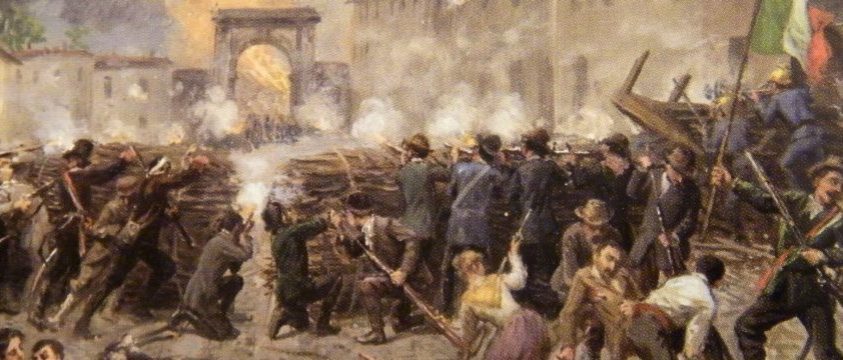Italian Unification: II Risorgimento
Posted on 25th February 2021
It is easily forgotten that Italy while an ancient land remains a relatively new country and one so young it is still suffering birth pangs. It had after all, not been unified in any respect since the fall of the Roman Empire in the in the 5th century and even this shared experience had been the result of conquest.
II Risorgimento or the Resurgence was an ill-defined movement that emerged in Italy in the years immediately following the defeat of Napoleon Bonaparte. It was a movement that sought a reinvigoration of art and literature in a land where it had once flourished but more importantly it desired a greater understanding of what it meant to be an Italian. It was not at first a movement for national unification, but it would in time become one.
Italian nationalism, in as far as it existed at all was a reaction to foreign occupation and rule with its greatest protagonist being the Habsburg Austrian Empire which dominated much of northern Italy but also ruled elsewhere in the country through its various surrogates and satellites. Indeed, it’s Chancellor Count Metternich while attending the Congress of Vienna which had been called to determine the shape of post-Bonaparte Europe had dismissively referred to Italy as “no more than a geographical expression” and in many respects he was right for Italy was divided up into competing small Kingdoms with the Italian people as disparate as their rulers. They owed their allegiance not to a country but to a region, a city, a town, or even a village and as a result the cause of Italian nationalism was never a movement of the people, there was never any great national uprising in support of independence and unification. It was always the movement of a small, educated elite and a dedicated band of political revolutionaries.
One of the first groups to form were the Carbonari, or Charcoal Burners, who can be said to have kept the flame of Italian nationalism alight in its early years. They were a conspiratorial organisation which took part in a series of abortive uprisings throughout Italy against French and Austrian occupation and one of its early adherents while he was in exile in the country was Louis Bonaparte, the nephew of Napoleon Bonaparte who as the Emperor Louis Napoleon III of France would play a significant role in the later development of Italy.
Three men were to play pivotal roles in the Risorgimento, the first intellectually, the second militarily, and the third politically. Without any one of them Italian unification may never have happened, and certainly not in the way it did.
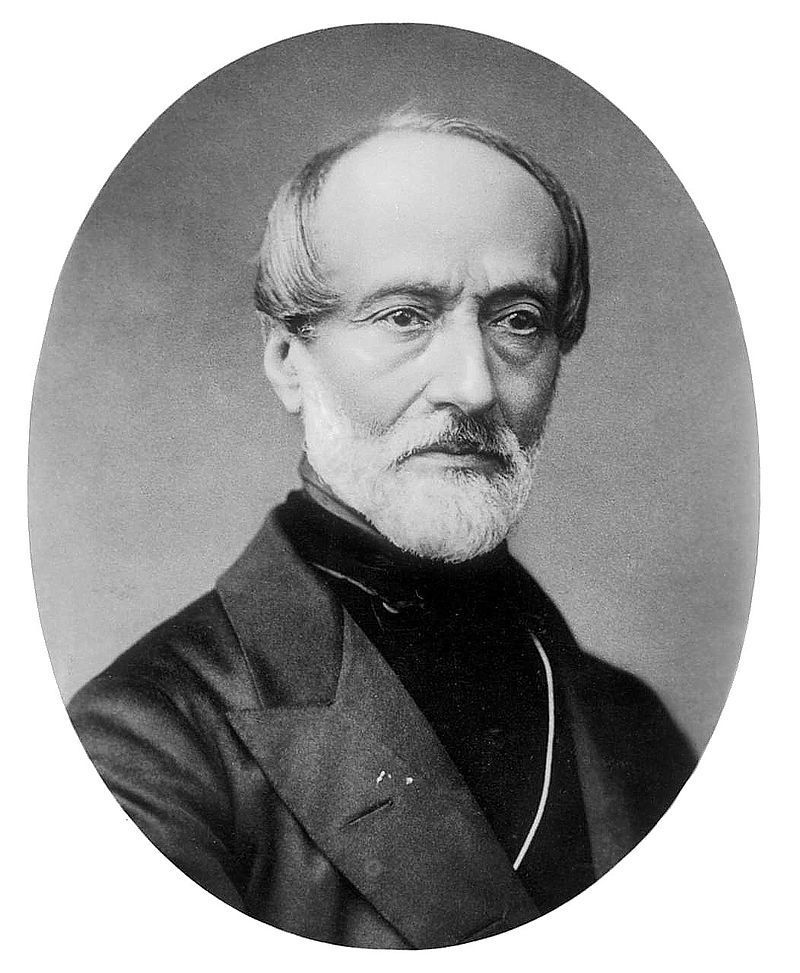
Giuseppe Mazzini, the Genoese lawyer known as the “Soul of Italy” was born on 22 June 1805, to a privileged family. His comfortable background permitted him to dream and what he dreamed of was a unified Italy. In his early years he channelled his energies into the writing of highly romanticised historical dramas but in 1830 whilst on a sojourn in Tuscany he encountered members of the Carbonari. The harsh reality of politics at first came as a shock to the idealistic young Mazzini but he soon adapted, and his views hardened. The failures of the Carbonari made him realise that it would take more than conspiratorial talk in dark places to bring about Italian unification. Having been briefly arrested, as much for his associations as his activities, he moved abroad so he could work more openly.
In 1831, he formed the secret society La Giovine Italia (Young Italy). Mazzini, however, no longer sought Italian unification for its own sake what he wanted was a Liberal Republic, and he was to be driven as much by his politics as he was his nationalism. Soon, the existence of La Giovine Italia was a secret in name only, and by 1833 it could boast 60,000 members – it had ceased to be a mere society and had instead become a movement.
Flushed with success that same year Mazzini initiated an insurrection in his hometown of Genoa. It was easily and brutally crushed, many were killed, and 12 of its ringleaders executed. Mazzini, who had managed to escape at the last moment was sentenced to death in absentia. Despite his own good fortune he remained haunted by the fate that had befell so many of his friends and he pondered with some anguish whether or not he wanted ever again to be responsible for sending others to their death.
Regardless of the failed rebellion in Genoa a well organised movement with Italian unification as its aim had at least been established, with had a political agenda, a philosophy, and an intellectual rigour that had previously been lacking, and the man responsible, Giuseppe Mazzini was to remain at the heart of the movement for the next 35 years.

Joseph Marie ‘Giuseppe’ Garibaldi was born in Nice, France, on 4 July 1807, to a sea-faring family, and he was to become not just a great Italian hero but one of the great men of his age admired and respected throughout the world. He was a very physical child who had displayed his courage at an early age when he saved a young boys life and by the age of 13, he was already working at sea. It was in meetings with Italian exiles during his many voyages that his revolutionary sentiments were first aroused, and he joined the Young Italy movement.
In November 1833, he met Mazzini for the first time in one of the few meetings they had which could be described as cordial. He then participated in the failed Genoa uprising also barely escaping with his life and like Mazzini being sentenced to death in absentia.
Forced to flee Italy, Garibaldi set sail for South America where he actively participated in the many liberation struggles taking place throughout the Continent often taking a leading role. It was in Brazil fighting for the rebel farrapos that he met his future wife the formidable Ana Ribeiro da Silva known as Anita, the daughter of a gaucho who taught Garibaldi how to hunt, ride, track, and shoot. Indeed, always a colourful character Garibaldi was to adopt their style of dress becoming famous for his trademark red shirt, poncho, and sombrero. By this time, fighting for republican causes in Uruguay, Brazil, and Argentina he had formed the Italian Legion which also adopted the uniform of the red shirt and flew the black flag in mourning for the subjugation of their native country. It was in South America that Garibaldi was to earn his reputation as a formidable military leader.
In June 1846, Giovanni Maria Mastai-Ferretti was elected as Pope Pius IX. He was a surprise choice as he had previously been associated with liberal causes and the Catholic Church was a deeply conservative institution. His election caused a great deal of excitement among Italian nationalists who had always believed that a liberal Pope would be the precursor to liberation from foreign oppression. As the head of the Church and the heir to St Peter he would be the focal point around which the deeply religious Italian people would rally. Such expectations were soon to be dashed however when the new Pope proved more interested in preserving the power of the Catholic Church than he was with any notions of Italian nationalism. As far as he was concerned the Italian people were already unified under the capacious skirts of Holy Mother Church.
In January 1848, a popular revolt in Sicily saw the Bourbon Monarchy ousted and what had at first appeared a small localised affair soon spread across Europe. Ideas of nationalism, liberalism, democracy, and even incipient socialism which had been simmering under the surface since the Enlightenment now burst forth and seemed about to sweep all before it. In February 1848, the Orleanist King Louis-Philippe was deposed in France and for a time the absolute monarchies of Europe teetered on the brink of collapse as Governments fell, King’s fled and previously denied constitutions and freedoms were granted in haste in desperate attempts to placate the rebels.
The always vulnerable Habsburg Empire came under intense pressure and the Emperor Ferdinand I was advised to leave Vienna after which on 13 March the hard-line Prince Klemen’s Metternich, one of the great Statesmen of Europe who had wanted to use the army to crush the revolution was forced to resign it being felt the ethnically mixed army it could be trusted.
Two days after Metternich resigned the Hungarian Diet in Budapest declared effective autonomy from the Austrian Empire. After an impromptu and unauthorised attempt to crush the rebellion was defeated politicians in Budapest demanded that Hungarian regiments in the Austrian Army be disbanded and returned to them.
If Italy was ever to free itself of the yolk of Austrian oppression it would be now and the most powerful man in the country King Charles Albert of Piedmont-Sardinia came under pressure to act. He reluctantly mobilised his army but declined to call for a national revolt. The idea of a greater-Italy unified with Piedmont at its centre had considerable appeal and had been a long-held ambition, but he too feared revolution.
Upon learning that revolution had broken out in Europe Garibaldi set sail from South America with 60 followers. Arriving in Italy he immediately offered his services to Charles Albert who was equally as quick to decline them. Undeterred, if he could not participate in someone else’s war then Garibaldi would fight his own. Collecting volunteers as he went, he fought and won a couple of minor engagements against the occupying Austrians. In the meantime, on 25 July 1848, the Piedmontese army went down to defeat the Battle of Custoza and Charles Albert was forced to sue for peace.
Yet again it seemed the latest attempt to achieve Italian unification had gone the way of all the others, but such was the disarray in Austria that despite their victory they were unable to stamp their authority on the country.
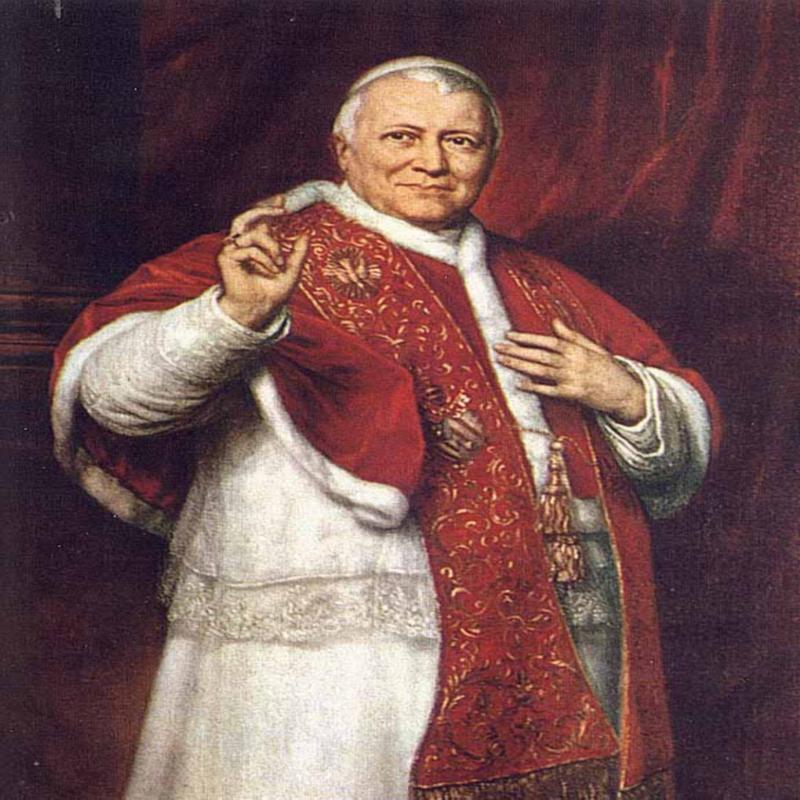
In Rome where republican sentiments remained high Pope Pius IX who had once again refused to support the cause of Italian unification had become a virtual prisoner in the Vatican; when one of his ministers was murdered in November, he excommunicated all those involved in the formation of the Republic and fled. The void left by the flight of the Pope was filled by Mazzini who now worked night and day on a new constitution for the city. On 9 February, much to his delight, the creation of the new Roman Republic was declared under a triumvirate with him as its de facto Chief Minister. The constitution he had formulated reflected the liberal values he had so long espoused, and it guaranteed religious freedom, provided free education for all, and abolished the death penalty. Rome would be a beacon for the rest of Italy but with the crushing defeat of Piedmont and with no popular rising in sight, Mazzini, who was not a military man, had no means off defending what he had created. In late March, Garibaldi arrived in the city.
Despite their many differences in the past and an unhealthy mutual distrust, Mazzini begged Garibaldi to take over military command and organise the defence of the city. Garibaldi agreed, but he was a leader and a man used to being in charge, he was not partial to collective decision making. During his time in Rome Mazzini and Garibaldi’s relationship was stretched to breaking point. He was to say of Mazzini, “he is a man of theory not of practice, who speaks constantly of the people but knows not who they are.” Mazzini was equally as scathing of Garibaldi describing him as an ignoramus who “has the face of a lion and is equally as stupid.” Nevertheless, they somehow managed to work together.
Encouraged by the events in Rome and the fact that other cities such as Venice and Mantua were still resisting Austrian rule Charles Albert renewed hostilities but on 23 March, 1849, his army once more went down to catastrophic defeat at the Battle of Novara. Forced to make a humiliating peace he abdicated his throne in favour of his son King Victor Emmanuel II. When the old King died soon after it seemed as if the last best hope of Italian independence had died with him.
Pope Pius IX having fled Rome now received reassurances regarding his safety should he return. Mazzini also informed him that the status of the Catholic Church and sanctity of the Vatican would be enshrined in the constitution of the new Roman Republic, but Pius was not reassured and instead appealed to Louis Napoleon who had recently come to power in France for assistance in recapturing the Papal States. Louis Napoleon, eager to make his mark and delighted to be considered Fedei Defensor, or defender of the faith, despatched an army to Italy to bring the Roman Republic to heel and restore the Pope to his rightful place.
Things did not go as planned however and on 30 April Garibaldi defeated the numerically superior French Army which was forced to retreat to the coast in a state of some disarray. Garibaldi was eager to follow up the victory and finish the job but Mazzini, who mistakenly believed that Louis Napoleon shared the same republican sentiments as his own thought he could achieve a negotiated settlement. Instead, Louis Napoleon shocked by the defeat greatly reinforced his army in Italy until it numbered more than 28,000. Garibaldi with barely 7,000 men of his own could no longer meet the French Army in the field and withdrew behind the walls of Rome. By 1 June, the city was invested, and the Siege of Rome had begun.
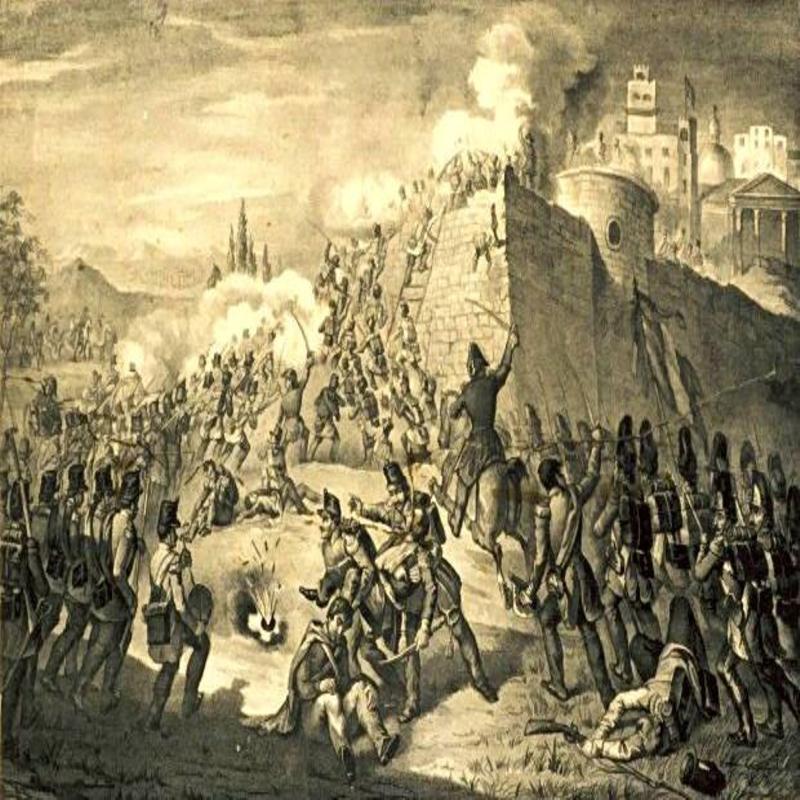
Garibaldi worked hard on the defences of the city and was a prominent and constant presence on the barricades. He was always more comfortable in the heat and dust of battle than he was discussing tactics in the drawing rooms of politicians, and he ensured that the siege was hard going for the French and several assaults were bloodily repulsed, but the outcome was inevitable. By 1 July the French had broken through the outer defences of Rome and its fall was now only a matter of time.
Mazzini and the Roman Assembly faced a dilemma; they could fight on bringing death and destruction on the city and as martyrs set an example to the rest of Italy; they could surrender and thereby save lives; or they could withdraw to fight another day. Garibaldi favoured the latter option and in an impassioned address told the assembled politicians: “Dovunque saremo, cola sara Roma.” (Wherever we may be, there will be Rome).
On 2 July, as Mazzini was negotiating a truce with the French, Garibaldi with 4,000 men withdrew from the city. Rome surrendered the following day.
Garibaldi and his small army were relentlessly pursued the length of Italy and during their epic march his heavily pregnant wife Anita died. He had little time to mourn. By the time he reached the relative safety of San Marino he had fewer than 250 men remaining. Not long after he took ship to Tangiers before making his way to New York. In the meantime, Mazzini had also avoided arrest and fled to Switzerland.
Following the fall of Rome those few enclaves still holding out in Italy also surrendered. The insurrection and first real attempt at some kind of Italian unification had been vague, uncertain, ill-coordinated and decisively crushed. The First Italian War of Independence, as it was to become known, was over.

While all the excitement was happening in Rome, Camilo Benso, the Conte di Cavour, was trying to clean up the mess that had been left by Piedmont’s disastrous war with Austria. Though he didn’t know it at the time, and it was never his intention, he was to be instrumental in the unification of Italy. He had always feared the ambitions of Garibaldi, Mazzini, and others like them who were determined to see Rome as the capital of some form of unified Italy. His vision did not stretch beyond creating a Kingdom of Northern Italy under the suzerainty of his beloved Piedmont. Over time and as the possibilities became more apparent his views modified.
The Conti di Cavour was by all accounts a cold and calculating man whose pragmatism and sense of realpolitik alienated the more avuncular and emotional Garibaldi. Indeed, he neither had friends nor sought to make any, the few relationships in his life that could be considered to have been close did not last long, but he worked hard for Italy.
In November 1852, he was appointed Prime Minister of Piedmont and was to triumph in the diplomatic drawing rooms of Europe every bit of much as Garibaldi triumphed on the battlefield. He was to play the Emperor Louis Napoleon III like a finely tuned piano working on his ego, his previous association with the Carbonari, and his insecurity as the lesser Bonaparte. He knew that only France could serve as the fulcrum for Italian liberation. He was to convince the French Emperor that the creation of an Italian State was not merely an ambition but a historical inevitability and that he could emulate his more famous uncle by making it a reality.
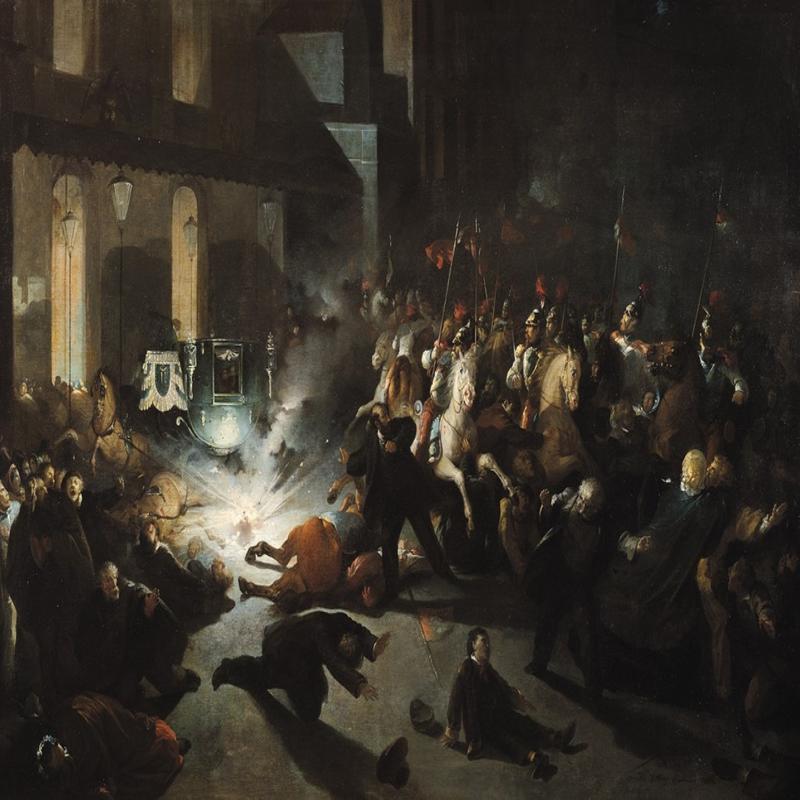
On 14 January 1858, Felice Orsini, a prominent Carbonari attempted to assassinate the now Emperor Louis Napoleon and his wife Eugenie as they travelled to the theatre on the Rue le Peletier in Paris. Three bombs were thrown at his carriage and 8 people killed with a further 142 wounded but the Emperor and Empress escaped unharmed. Orsini, himself injured, was captured at the scene. Later while awaiting execution in his prison cell, he wrote the Emperor a letter: “Set my country free, and the blessings of twenty-five million people will follow you everywhere and forever.”
In July 1858, Cavour met with Louis Napoleon in secret at Plombieres-les-Bains in France. After lengthy and often painful discussions it was agreed that if Cavour could engineer a conflict with Austria, France would come to Piedmonts aid. In negotiating the deal Cavour was forced to cede Savoy and Nice permanently to France, an act that Garibaldi would never forgive him for. Cavour’s plan was almost scuppered however when it was proposed that the Italian issue be settled by a specially convened congress of nations. Cavour knew that any such congress would invariably favour Austria and that the most that could be achieved would be some sort of truncated partial unification designed to ensure Piedmont remained weak and vulnerable.
Cavour now ensured that Piedmont’s response to the planned congress was so aggressive in tone that the Austrian’s took offence and fearing that Piedmont’s intentions were warlike sent an ultimatum demanding they disarm. When Piedmont refused Austria declared war on 29 April 1859.
Cavour had got the war he wanted but he also knew that Piedmont could not hope to win it without the French support he had been promised. He need not have worried for Louis Napoleon was as good as his word, for now at least.
By late May a French army 60,000 strong was in Italy and it wasn’t to be long before they saw action. On 4 June, at the Battle of Magenta they decisively defeated a numerically superior but incompetently led Austrian army. This had been a bloody but minor engagement however, three weeks later, on 24 June, the two armies would meet in force near the village of Solferino just south of Lake Garda.
The French army had by this time been reinforced by the Piedmontese and their combined force numbered around 140,000. Louis Napoleon had earlier joined his army in the field and taken personal command, as also had King Victor Emmanuel. Likewise, the Emperor Franz Joseph, appalled by the incompetence displayed at Magenta had arrived to take command of his Austrian army of 130,000 – the coming Battle of Solferino was also the Battle of the Three Kings.
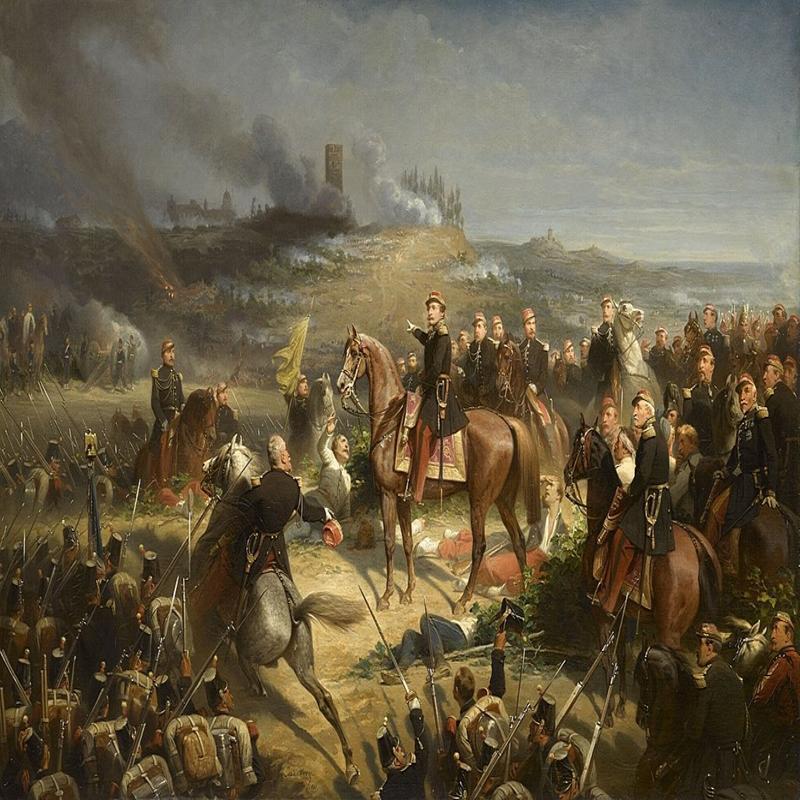
The battle that took place at Solferino was to be a brutal and bloody affair that lasted over 9 hours. It was to result in a decisive French/Piedmontese victory as the Austrians were forced to retreat to a defensive line of fortresses centred upon the city of Verona known as the Quadrilateral. It was a victory bought at a high price however, the combined French and Piedmontese army had suffered 17,191 casualties including 2,313 killed; the Austrians had lost 22,310 men more than 3,000 of whom had been killed.
Solferino had been the bloodiest battle on European soil since Waterloo and a Swiss national Henri Dunant who had witnessed its immediate aftermath was so appalled at what he saw, the wounded left to die on the battlefield and disarmed prisoners being bayoneted to death that he recorded it all in a book A Memory of Solferino. It was the book that inspired the creation of the Committee of the International Red Cross in 1863 and the calling of the First Geneva Convention that formulated for the first-time rules of conduct in warfare the following year.
Any sense of triumphalism on Cavour’s part was to be short-lived, however. Louis Napoleon who had been sickened by the scenes he had witnessed at Solferino wanted to conclude the war as soon as possible and without consulting either Cavour or Victor Emmanuel he signed a separate armistice with the Austrians at Villafranca. Cavour, who’d had the rug pulled out from under him, was furious. All he had achieved for Piedmont was the acquisition of the neighbouring territory of Lombardy and in a state of high dudgeon he resigned in protest.

But King Victor Emmanuel soon discovered that he could not do without his Chief Minister and by January 1860 he had been persuaded to return.
It would not be long before the reinstated Cavour realised that the Austrians had taken such a mauling in the recently concluded conflict that they were no longer willing or able to resist Piedmont’s territorial ambitions and in the following months he was to bring most of northern and central Italy under their control and here he would have been willing to stop. He had had little interest in the poor and under-developed south. But events were soon to spiral beyond his control.
The Austrians had been militarily humbled, and Piedmont’s power and influence extended but to Italian nationalists this meant little and the unification of their country seemed as far away as ever. It was to be Garibaldi who would provide the spark that would re-ignite the fire of Italian liberation.
On 4 April 1860, a popular insurrection broke out in Palermo and Garibaldi, who had been planning to re-take Savoy from the French, now turned his attention to Sicily. His request for troops from Piedmont had been denied by Cavour who deeply distrusted him. So instead, he raised his own army of 1,085 volunteers, known as II Mille (The Thousand) and in May led them, his Red Shirts, to Sicily where they received a rapturous reception. Reinforced by local volunteers he defeated the superior forces of the Bourbon Monarchy that ruled the island and much of southern Italy at the Battles of Calatafimi and Milazzo. Following their defeat what remained of the Bourbon Army withdrew to the mainland leaving Sicily under Garibaldi’s control. Cavour immediately tried to incorporate the newly liberated Sicily into Piedmont, but Garibaldi refused. He then begged Garibaldi not to cross the Straits of Messina and invade the Kingdom of Naples, he refused. He then threatened that there would be consequences if he did, again Garibaldi refused.
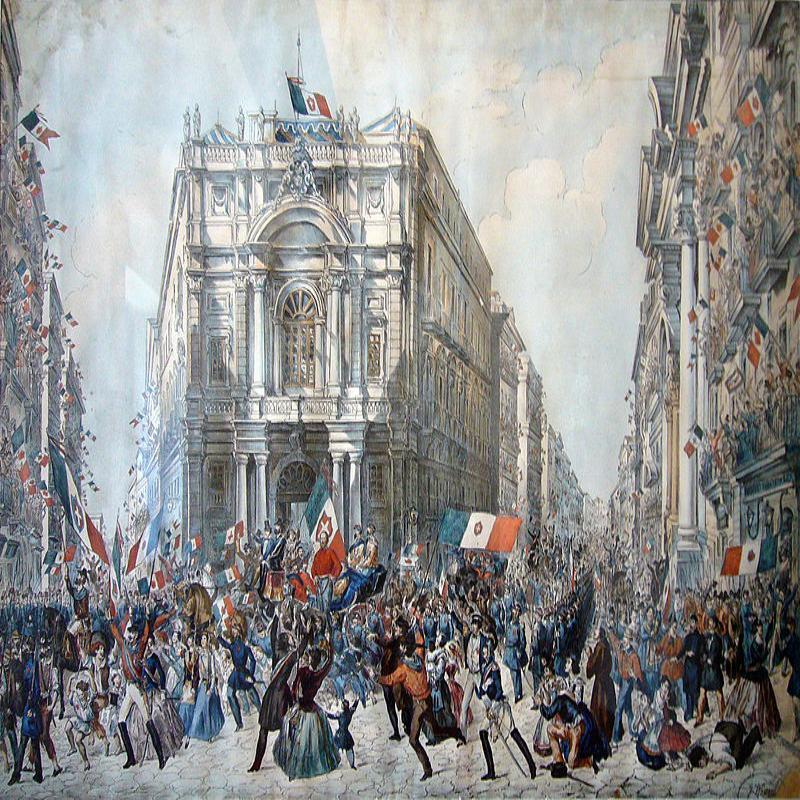
On paper at least the ruling Bourbon Monarch of the Kingdom of the Two Sicily’s as it was known, Francis II, could call upon a powerful army of 150,000 men but the deeply unpopular Bourbon’s had long been reliant upon their Swiss Guard to maintain them in power when they were forced to disband and return to Switzerland it quickly dawned on Francis that few people in his Kingdom were willing to fight for him. When in early August Garibaldi crossed over to Reggio-Calabria the Neapolitan navy stood aside and the garrison promptly surrendered to him. As he and his men advanced on Naples, they met little resistance and almost everywhere they passed they were greeted as conquering heroes. On 6 September, Francis II declared a state of siege in Naples but there was to be no siege. Later that same day he fled taking the 4,000 or so troops that remained loyal with him. The following day Garibaldi entered the city.
Triumphant though he was Naples was not the end of Garibaldi’s ambitions, he remained determined to march on and capture Rome making the city the capital of a unified Italian State. Learning of this threw Cavour into a panic, Rome and the Papal States were still defended by the French Army and any attack on Rome would be the equivalent of a declaration of war and all that had been gained through years of diplomacy and martial conflict would be lost. He, along with King Victor Emmanuel, now mobilised the army and marched south with the intention of stopping Garibaldi, by force if necessary.
Francis II may have fled Naples but he had not given up all thought of retaining his kingdom and having retreated north into Campania he established a camp on the Volturno River. His army had since been reinforced by further loyal Neapolitan regiments and Swiss and German mercenaries until it numbered just over 40,000. This was almost twice the number of troops available to Garibaldi and when the two armies clashed on 1 October at the Battle of the Volturno a bloody stalemate ensued that was in reality a defeat for Garibaldi for with Francis also in control of a number of well-defended fortresses he realised that he could not be victorious or hope to achieve his ambitions without Piedmontese support.
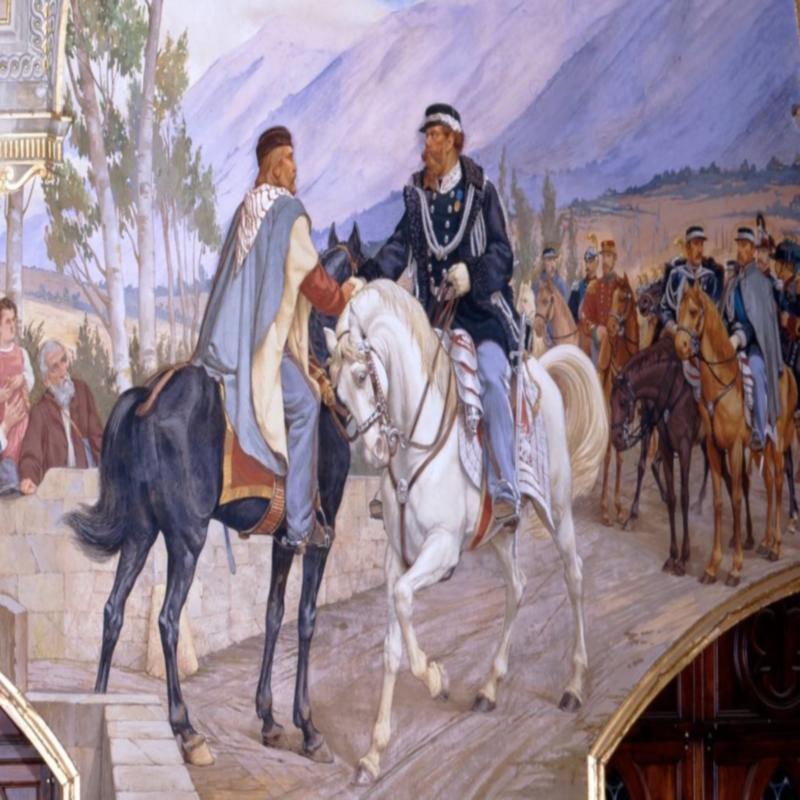
Cavour had expected his meeting with Garibaldi to result in a clash of arms, but the circumstances had now changed. When the two forces met at the small town of Teano on 27 October 1860, a seemingly chastened Garibaldi rode up to Victor Emmanuel and removing his hat took him firmly by the hand and declared him King of all Italy. This was not yet a reality, Veneto and the Trentino remained in Austrian hands and the Papal States was still nominally independent though in truth an enclave of French control. Even so, it seemed as if the long-held dream of patriots and visionaries that Italy would one day emerge as a sovereign state was about to be realised.
King Victor Emmanuel II, the Conti di Cavour and Garibaldi now travelled onto Naples where Garibaldi and the King riding side-by-side held hands as they weaved their way through the jubilant crowds.
Francis II besieged in the fortress of Gaeta now bowed to the inevitable and surrendered - the Kingdom of Naples belonged to Piedmont.
On 17 March, Victor Emmanuel was formally crowned King of Italy and Rome named its capital, though it was not yet in the hands of the new Italian State, so Turin was to be the de facto capital.
Upon the outbreak of the Franco-Prussian War the French garrison was withdrawn from Rome and after easily brushing aside the Papal Army the city was occupied in September 1870. Following the defeat of Louis Napoleon and his subsequent abdication Rome was pronounced the centre of Government of the Italian State on 2 July 1871.
Giuseppe Mazzini, the man who more than any other had turned the century old dreams of Italian nationalists into a reality had effectively been side-lined by events. He had swum against the tide of history by denouncing Cavour’s alliance with the Emperor Louis Napoleon and criticising Garibaldi’s vainglory. He was to turn up too late in Sicily to play a role in Garibaldi’s liberation of the island and when he travelled onto Naples, he was told by Garibaldi’s deputy in no uncertain terms to leave.
Mazzini was a republican through and through and could not reconcile himself with the fact that the new Italian State was monarchy. As such, he refused a seat in the Italian Chamber of Deputies and continued to oppose the regimeeven spending a period in prison. History had effectively passed him by, but he had not been forgotten. When he died of pleurisy on 10 March 1872, aged 66, more than a 100,000 people turned out in Genoa to watch his funeral cortege pass by.
The Conti di Cavour did not live to see Rome reunited with Italy. He had been appointed the first Prime Minister of Italy on 23 March, 1871, but died less than three months later on 6 June, aged just 50. He remarked just prior to his death: “Italy is made. All is safe.”
Giuseppe Garibaldi’s reputation as the selfless revolutionary appeared confirmed when Victor Emmanuel wishing to reward him for all he had done offered him any honour it was in his gift to give. Garibaldi merely asked for a bag of beans and to be allowed to retire to his farm on the Island of Caprera.
Such had been his fame that in 1862, despairing of the incompetence of his own Generals, President Abraham Lincoln offered Garibaldi command of the Union Army fighting the Confederacy. He declined the offer on the grounds that the President had not at the time made plain his intention to abolish slavery.
In 1866, he made one last abortive attempt to liberate Rome before retiring to his farm for good.
Garibaldi fell seriously ill in the spring of 1882 and requested that his final hours be spent looking out upon the sea. On 2 June, aged 74 and surrounded by family and friends, the man of action, one who had taken so many risks throughout his life and had been one of the great men of his age, died peacefully in his bed.
Tagged as: Miscellaneous
Share this post:





